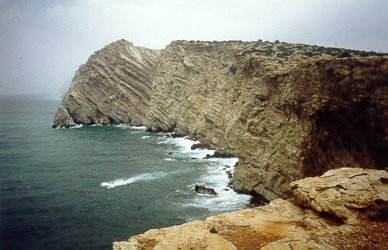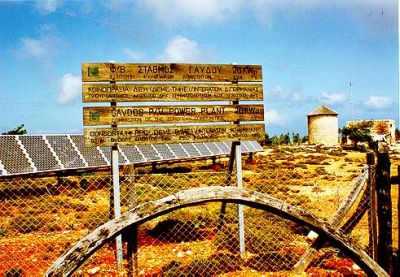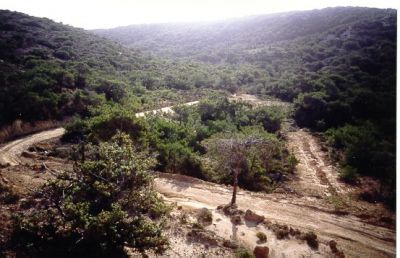|
THE ISLAND OF CLAUDA, NOW CALLED GAVDO ITS APPEARANCE, GEOLOGY AND GENERAL
DESCRIPTION AN ANCIENT SITE AND STATUE A BISHOP OF CLAUDA TRADITION AND OPINION
OF ITS FORMER CONNEXION WITH CYRENE NEGATIVED BY THE DEPTH FOUND BY SOUNDING
BETWEEN INTERESTING PHYSICAL FACT OF THE GREAT DEPTH OF THE SEA PROXIMATE TO
CRETE.
 The description of Crete can hardly be closed without some notice of the
island of Clauda, Iying directly opposite to Sfakia and its port of Lutro, since
it will, in conjunction with the latter port, ever possess a special interest
from the notice of them both in the events connected with St. Paul's perilous
voyage and shipwreck after quitting Fair Havens, which I have very fully dwelt
upon in the first two chapters of this volume. For it will be remembered that it
was under the lee of this island of Clauda, that the ship, after being struck or
caught by the fury of the Euroclydon in endeavouring to cross the intermediate
channel for the port of Phoenice, ran for temporary shelter, and the mariners,
it is said, undergirded the ship, and had much difficulty in saving their boat. The description of Crete can hardly be closed without some notice of the
island of Clauda, Iying directly opposite to Sfakia and its port of Lutro, since
it will, in conjunction with the latter port, ever possess a special interest
from the notice of them both in the events connected with St. Paul's perilous
voyage and shipwreck after quitting Fair Havens, which I have very fully dwelt
upon in the first two chapters of this volume. For it will be remembered that it
was under the lee of this island of Clauda, that the ship, after being struck or
caught by the fury of the Euroclydon in endeavouring to cross the intermediate
channel for the port of Phoenice, ran for temporary shelter, and the mariners,
it is said, undergirded the ship, and had much difficulty in saving their boat.
The modern name of the island is Gavdo or Ghavdo, although it is strangely
corrupted into Gozzo by Italian navigators.  Its
general appearance from a distance is flat (having no defined peak), with
whitish cliffs forming the northem and eastem parts of its coast; and it is not
high as compared with Crete, although it is much higher than Malta, its altitude
heing nearly 1000 feet. The south coast of the island is straight and high,
forming a continuous precipice, the summit of the island being just over the
cliff from which it declines gradually to the northern shore, where it is low
and rocky, with several outlying dangers; and the watershed down it in this
direction has consequently channelled its surface into long parallel and deep
ravines running in the direction of the dip or inclination of the strata. These
deposits much resemble the lower group of those of Malta, and seem to be
identical from the sea-eggs and sharks' teeth found in them: they correspond
also with the upper series of deposits upon the Cyrene coast, which overly the
nummulitic limestones there. But the southem cliffs of the island of Gavdo are
composed of the unfossiliferous and unconformable brown and blue shales and
schists so frequent in Crete. Its
general appearance from a distance is flat (having no defined peak), with
whitish cliffs forming the northem and eastem parts of its coast; and it is not
high as compared with Crete, although it is much higher than Malta, its altitude
heing nearly 1000 feet. The south coast of the island is straight and high,
forming a continuous precipice, the summit of the island being just over the
cliff from which it declines gradually to the northern shore, where it is low
and rocky, with several outlying dangers; and the watershed down it in this
direction has consequently channelled its surface into long parallel and deep
ravines running in the direction of the dip or inclination of the strata. These
deposits much resemble the lower group of those of Malta, and seem to be
identical from the sea-eggs and sharks' teeth found in them: they correspond
also with the upper series of deposits upon the Cyrene coast, which overly the
nummulitic limestones there. But the southem cliffs of the island of Gavdo are
composed of the unfossiliferous and unconformable brown and blue shales and
schists so frequent in Crete.
Ghavdo contains about
seventy families, scattered over it in three or four hamlets and farms. The
property of the island generally belongs to the Sfakiots; and the inhabitants
being only their tenants, are consequenty poor. They are primitive in their
habits and ideas, and moreover are without enterprise and energy, a mixed and
degenerate race; for the island having been made a place of resort by the old
Levantine corsairs, Maltese cruisers during the middle ages and later times,
these left their imprint strongly marked in the features and temperament of many
of its inhabitants, as in Antiparos and other islets of the archipelago. And so
inconsiderate was their curiosity, on the first arrival of my ship, that several
swam off to her soon after anchoring, and suprised us by hoarding her from the
gangways and bows in state of nudity, just like the uncivilized natives of the
Pacific islands. The island presents to the eye a rather barren, unproductive
appearance, having no trees or shrubs, excepting a few karoubs in the valleys,
and a sort of stunted juniper growing amidst the hlown sands upon the northem
shore; for the olive-tree cannot flourish upon the hills, from their entirely
northem aspect rendering them exposed to the force of the frequent Luroclydon
squalls during every "meltemi".  There are no indentations or bays, nor any
safe anchorage, except on the east side, and there it affords only a temporary
shelter from a westerly gale. There are no indentations or bays, nor any
safe anchorage, except on the east side, and there it affords only a temporary
shelter from a westerly gale.
Upon a flat but steep
eminence terminating close over the north shore, near its north-west extreme,
there is a small site with Hellenic remains, from which I procured a finely
draped but headless colossal female statue in Parian marble, a very fine
specimen of Greek art, and which I soon afterwards had the gratification of
presenting to the British Museum. It had been discovered, a few years previously
by the peasants when tilling the sail, and when I saw it Iying neglected upon
the surface surrounded by the daily chipping wantonly and thoughtlessly made by
the shepherdboys for pastime, I was induced to remove it to save so valuable a
specimen of Cretan sculpture, and, by the consent of the party in possession of
the spot, was fortunately enable to do so; otherwise it would ere long have been
a disfigured block of marble, and not worth the time, trouble, and expense
incurred.  There must have been a temple near where the statue was found,
together with the acopolis of the only ancient city in the island. From what
remains, it must have been at that rime a v ery small city, and not of
sufficienlt importance to have its own coinage, as no coins of this island are
known, and I could nor learn that any had ever been found by rhe natives. There must have been a temple near where the statue was found,
together with the acopolis of the only ancient city in the island. From what
remains, it must have been at that rime a v ery small city, and not of
sufficienlt importance to have its own coinage, as no coins of this island are
known, and I could nor learn that any had ever been found by rhe natives.
Yet, according to rhe showing of Dr Cramer (vol. iii p. 376). there was a
Bishop of Clauda. and therefore it must have heen populous and of some
importance in rhe early days of Christianity; the island, however, is not more
rhall five miles in lengtlh by ahout three in breadth; so that I think it
probable that within the see were included the inaccessible part of the Sfakian
territory and coast lying opposite to it, with which, no doubt, then as now,
communication by boat was frequent. My general observations of rhe geology
of parts of the opposite coast of Crete and of Ghavdo have shown that the latter
is chiefly a fragment of what are supposed to he deposits of the niocene
tertiary peliod, and therefore a sort of link between those deposits on the
coast of Crete and on that of Cyrene, but it is apparently separated from Crete
by a chasm nearly 1000 fathoms deep, and from Cyrene by a depth of upwards of
l500 fathoms.  Yet I found a tradition existing among the inhabitants that
there was a submarine bank or shallow between Gavdo and Cyrene. which the
well-known French tralveller Sonani having heard of accepted as a fact, and
attributed the separation, with this shallow connexion between, to the abrading
effect of currents. He thus divided the eastern half of the Mediterranean into
two deep basins, viz one between the Malta channel and the Cynene or Cretan
channel, and the other benween the Cyrene channel and Syria. This tradition,
however, is entirely negativated by the deep soundings we have obtained off part
of Crete and between Ghavdo and Cyrene. Even at only fifteen miles to the south
of the south-west exneme of Crete we found by a single sounding. hut perfectly
reliable, a depth of no less than 1950 fathoms. or nearlly 12000 feet; and in
allprobability, this is not the deepest.being rhe only one raken Thus, as rhe
While Mountains as this end of the island are 8000 feet high. There is a
suhmarinle valley under or rather off it. that is about 4000 feet deeper below
the surface of the sea than either the White Mountains or Mount Ida are ahove
it; therefore if we add the heigth of these mountains viz.8000 feer. to this
remarkable depth so near to the island of Crete, we have a result indicating a
difference of level. between the bed of the Mediterranean here and rhe top of
the White Mountains, of nearly 20000 feet in a distance of about twenty-five
miles, thereby giving a contour of the subbaerial and submarine Stata of the
earth of this part of the Mediterranean almost equal in vertical dimension to
that of some of the highest mountain-ranges in the world, and exceeded by few in
boldness. Yet I found a tradition existing among the inhabitants that
there was a submarine bank or shallow between Gavdo and Cyrene. which the
well-known French tralveller Sonani having heard of accepted as a fact, and
attributed the separation, with this shallow connexion between, to the abrading
effect of currents. He thus divided the eastern half of the Mediterranean into
two deep basins, viz one between the Malta channel and the Cynene or Cretan
channel, and the other benween the Cyrene channel and Syria. This tradition,
however, is entirely negativated by the deep soundings we have obtained off part
of Crete and between Ghavdo and Cyrene. Even at only fifteen miles to the south
of the south-west exneme of Crete we found by a single sounding. hut perfectly
reliable, a depth of no less than 1950 fathoms. or nearlly 12000 feet; and in
allprobability, this is not the deepest.being rhe only one raken Thus, as rhe
While Mountains as this end of the island are 8000 feet high. There is a
suhmarinle valley under or rather off it. that is about 4000 feet deeper below
the surface of the sea than either the White Mountains or Mount Ida are ahove
it; therefore if we add the heigth of these mountains viz.8000 feer. to this
remarkable depth so near to the island of Crete, we have a result indicating a
difference of level. between the bed of the Mediterranean here and rhe top of
the White Mountains, of nearly 20000 feet in a distance of about twenty-five
miles, thereby giving a contour of the subbaerial and submarine Stata of the
earth of this part of the Mediterranean almost equal in vertical dimension to
that of some of the highest mountain-ranges in the world, and exceeded by few in
boldness.
|